Black Dog. Whole Lotta Love. Dazed and Confused.
To name just a few of Led Zeppelin’s classic guitar anthems is to conjure up the specters of Jimmy Page’s otherworldly guitar prowess. Many of the sounds that man wrenched from his instrument are well beyond human understanding even to this day.
But there is hope. Hope for mere mortals like us to attain godlike tones, whatever modest blessings the creator bestowed upon us. And that hope? That hope, my friends, is GEAR.
Everyone knows the ‘59 Les Paul, the Marshall 100s, and the Dragon Telecaster. Alas, these are but a small part of the equation.
In this article, we’ll complete the puzzle and clue you into how Jimmy Page accomplished some of his most legendary guitar sounds during his time with Led Zeppelin (and show you where to get the gear!).
Read on, and you might just find yourself on that Stairway to Guitar Heaven after all.
Led Zeppelin's 10 Favorite Guitar Accessories
1. Supro Thunderbolt 1x15” Tube Amp
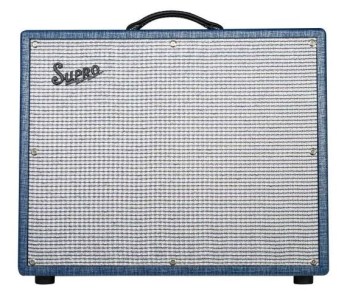
Like the much more famous Fender Bassman, the Supro Thunderbolt was designed and marketed by Supro as a bass amplifier. But one minor issue prevented it from attaining the status of its tweedy cousin: it sounded terrible.
As a bass amp, it was all wet – but it found new life in the 1960s as a filthy tube-driven tone machine ideal for creating high-gain situations in the studio, and this was not lost on session-guitarist-on-the-make Jimmy Page.
A tonal explorer from the very beginning, Page used his Supro Thunderbolt all over Zeppelin I, as well as on the legendary “Stairway” solo.
The revamped Supro brand reissued a limited run on the Thunderbolt amp, which sadly suffers spotty availability – but the same great Supro tube tone can be yours with one of their other impressive and stylish combo amps.
2. MXR Phase 90

This all-time classic phaser pedal can be heard all over the music of the 1970s, from rock to funk and even country. Jimmy Page was certainly a trendsetter when it comes to guitar tones, so it’s not surprising that this pedal made appearances on Zep’s output throughout the 70s.
The Phase 90’s whooshy, watery warble can be heard on such classic tracks as “Immigrant Song,” “Dazed and Confused,” and very prominently on Physical Graffiti’s “The Rover.”
The MXR Phase 90 has appeared in numerous iterations over the years that are coveted for various reasons, but today’s readily available model offers the same great swirling sound that will instantly transport any player back to the 1970s.
3. Vox Wah-Wah Pedal
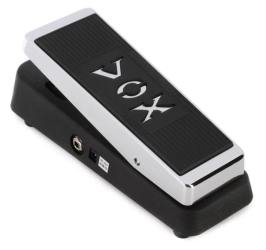
Another classic pedal that was used in various iterations by Jimmy Page during the Zeppelin years was the Vox wah-wah.
Wah-wah adds a bluesy, expressive vibe to lead guitar playing that lends itself perfectly to sweeping psychedelic rock solos and, as such, was a staple of the 1960s-70s guitar rock that Zep was at the pinnacle of.
Page most famously used a Vox V846 wah on several classic Led Zeppelin tracks, including “Dazed and Confused,” “Since I’ve Been Loving You,” and “The Lemon Song.”
And while the V846 is not widely available, Vox currently manufactures a reissue of its successor, the V847-A, which, in the right hands (foot?), will take you to Zeppelin territory with no problem.
4. Danelectro Stock ‘59
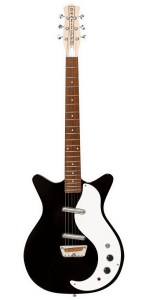
The name Jimmy Page is practically synonymous with his “Number One” ‘59 Gibson Les Paul, and only marginally less so with his famous Dragon Telecaster, so many casual Zeppelin fans might not be aware that Page actually accomplished many of his signature sounds with a much less storied instrument: the unassuming Danelectro Stock ‘59.
The Dano ‘59 was Page’s go-to for slide work – this is the guitar you’re hearing on “In My Time of Dying,” as well as much of the rest of Physical Graffiti album, including such tracks as “Kashmir” and “Custard Pie.”
As exemplified by Page’s work, this affordable axe is capable of some really unique tones. What’s more, Danelectro has never forgotten where they made their bones – a brand-new ‘59 stock can be yours today. Don’t forget to pick up a slide while you’re at it!
5. MXR M103 Blue Box Octave Pedal

Jimmy Page used this octave fuzz to create his iconic guitar sound on the Led Zeppelin song “Fool in the Rain.”
The MXR Blue Box uses a combination of a fuzz circuit with a frequency divider to create a gritty, aggressive, and somewhat unpredictable sound that's characterized by a mix of harmonically rich distortion and a sub-octave undertone.
And while this pedal didn’t get a ton of use with Zeppelin outside of that one example, you certainly can – it’s a really fun pedal to play around with. The blend knob dialed down will allow you to get manageable, musical sounds like the “Fool” tone.
Dial it up, however, and you will get into some seriously psychotic sonic territory, into the likes of which even the Dark Magus himself dared not venture.
6. Vox AC30

While it’s not totally surprising that one of the most famous British guitarists of all time used one of the most famous British guitar amps of all time, we thought it was worth mentioning that Page used a Vox AC30 in various studio applications throughout his time with Zeppelin and beyond.
More often than not photographed onstage with an array of Marshall and Orange amps (representing the more powerful and flamboyant side of British amp manufacture), Page favored smaller combo amps in the studio and, therefore would make use of a Vox AC30 on occasion, perhaps most famously on “Communication Breakdown.”
Today, Vox manufactures an AC30 just like the one Page would have used in the 1960s, featuring Alnico Blue speakers and a Top Boost channel (Jimmy’s was modified by hand to feature a treble boost, not a standard feature at the time), so you can get high-gain British blues rock tones of your own – chops not included.
7. Sola Tonebender Pedal
Widely considered one of the original fuzz pedals, the Sola Sound Tonebender is arguably the fuzz sound of the 60s, appearing on many classic records of the era and used extensively by Jimmy Page in his recordings and performances with the Yardbirds as well as Led Zeppelin.
A simple pedal with only two controls (level and attack) and a footswitch, the Tonebender was designed to provide an aggressive distortion and sustain so as to allow an electric guitar to emulate a horn section.
Page used this pedal to great effect on “Heartbreaker” and “Communication Breakdown,” among many other raucous blues workouts with the band.
How Can I Get This Sound Today?
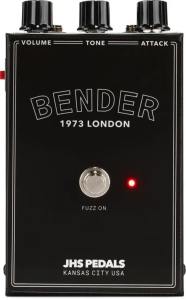
While an authentic Sola Tonebender is not readily available to the general public, JHS Pedals manufactures an awesome copy, the JHS Bender, which will get you the same Germanium fuzz sound made famous in the 1960s by Jimmy Page and his ilk.
8. Maestro Echoplex EP-3
Jimmy Page used the legendary Echoplex tape delay unit extensively with both his guitar and theremin setup live and in the studio. This unit uses a tape loop to create a delayed signal that creates an adjustable echo effect with a lot of really unique sonic characteristics.
Whether it’s a subtle chorus, slapback, or a long modulated echo, the EP-3 does it all – and Jimmy Page used it for all this and more on many, many classic Zeppelin tracks as part of his main guitar rig.
How Can I Get This Sound Today?
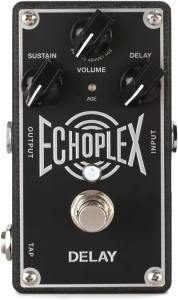
While vintage Echoplex units are available secondhand today, they are hard to find, usually pricey, and very difficult and time-consuming to maintain and service.
You’d be much better off purchasing a Dunlop EP103 Pedal, an all-analog delay pedal that perfectly simulates the original EP-3’s characteristics, from delay time, sustain, and even tape “age,” as the Echoplex tape’s sound becomes darker with age.
9. Binson Echorec
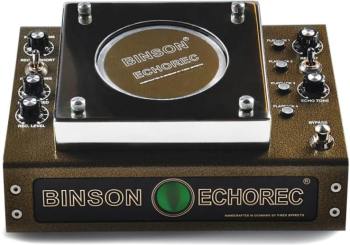
Another legendary delay unit employed by Led Zeppelin is the Binson Echorec. This unit provides a more expansive and versatile array of delay effects that makes it ideally suited for studio use.
Page and co. made good use of the Echorec, most notably in “Whole Lotta Love,” with its psychedelic breakdown section, as well as using it to create the much-mythologized “When The Levee Breaks” drum sound.
How Can I Get This Sound Today?
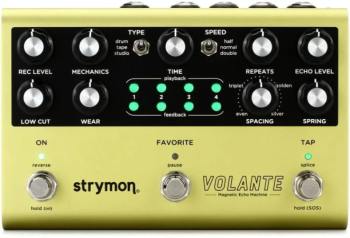
While T Rex Effects produces a Binson-licensed Echorec reissue today, you can get its classic sound in pedalboard-ready form with the Strymon Volante.
This pedal is basically a digital copy of the legendary analog delay unit, so you can get all the control and versatility of the original in a pedalboard-friendly footprint.
10. Universal Audio 1176LN Classic Limiting Amplifier

Of all the legendary guitar tones in the classic rock pantheon, few have been more hotly contested over the years than Jimmy Page’s searing tone on the Led Zeppelin song “Black Dog.”
Much of the mystery comes from the fact that the tone relies heavily on multiple layered tracks, which is not an easy sound to accomplish in a live setting. But that’s not all – Jimmy, in fact, didn’t use an amp or pedal to speak of on this song.
The signature “Black Dog” tone was accomplished by plugging Page’s Les Paul straight into the mixing console and running it through two successive UA 1176 Limiters for gain and compression. The result of this experiment was the incredibly distorted, chunky tone you hear on the record.
How Can I Get This Sound Today?
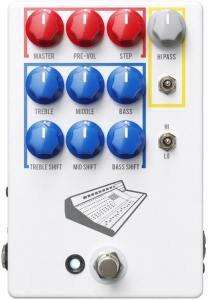
While those of us fortunate enough to own our own recording studio can purchase a couple of UA 1176s to plug into our sumptuous mixing console, the rest of us will have to settle for something we can squeeze onto our humble pedalboards.
The JHS Colour Box pedal, however, is hardly a compromise – this awesome pedal is capable of not only the overdriven console tone heard on “Black Dog,” but you can also mimic the Beatles’ “Revolution,” Pink Floyd’s “Another Brick in the Wall,” and many other classic rock tones that were accomplished through similar means.
Couple that with a Keeley 30ms Double Tracker, which creates an amazing automatic double-tracked stereo signal, and you’ve got the “Black Dog” Sound Dialed.
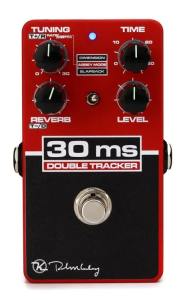
Conclusion
The mark Jimmy Page and Led Zeppelin left on the rock guitar landscape is indelible. Never before had the world heard such stunningly psychedelic and visceral sounds issue forth from the humble six-string, and it’s safe to say the music world was never the same thereafter.
It’s shocking, then, to find that many of Page’s signature sounds were created through the ingenious combination of readily available contemporary effects pedals, amps, and guitars, and of course, a massive talent.
Now that we’ve told you how to attain some of Jimmy Page’s most legendary guitar tones, head to Sweetwater and put your own talent to the test if you dare!
Discover the incredible sound of the Supro 1614RT Amulet! Read our review now.
